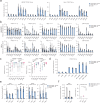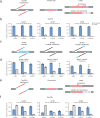Dual inhibition of DNA-PK and Polϴ boosts precision of diverse prime editing systems
- PMID: 40341582
- PMCID: PMC12062269
- DOI: 10.1038/s41467-025-59708-z
Dual inhibition of DNA-PK and Polϴ boosts precision of diverse prime editing systems
Abstract
Prime editing is a genome engineering tool that allows installation of various small edits with high precision. However, prime editing efficiency and purity can vary widely across different edits, genomic targets, and cell types. Prime editing typically offers more precise editing outcomes compared to other genome editing methods such as homology-directed repair. However, it can still result in significant rates of unintended editing outcomes, such as indels or imprecise prime edits. This issue is particularly notable in systems utilizing a second nicking gRNA, such as PE3 and PE5, as well as in dual pegRNA systems and fully active nuclease systems such as PEn, which increase efficiency but compromise precision. In this work, we show that pharmacological inhibition of DNA-PK and Polϴ, two major mediators of mutagenic DNA repair pathways, improves precision of PEn, PE3, PE5, PE7, and dual pegRNA editing systems, including TwinPE, HOPE, and Bi-PE, across multiple genomic loci and edit types. We show that co-inhibition of DNA-PK and Polϴ mitigates both prime editing-unrelated indels and prime editing by-products such as template duplications. Moreover, in the case of PEn, this strategy also substantially improved the off-target editing profile. Together, our data establish small molecule modulation of DNA repair pathways as a general strategy to maximize the precision of diverse prime editing systems.
© 2025. The Author(s).
Conflict of interest statement
Competing interests: All authors are current or former employees of AstraZeneca and may be AstraZeneca shareholders. L.D. is an employee of Promega corporation. AstraZeneca filed patents related to this work (WO2021204877A2 and WO2023052508A2).
Figures





References
MeSH terms
Substances
LinkOut - more resources
Full Text Sources
Research Materials

